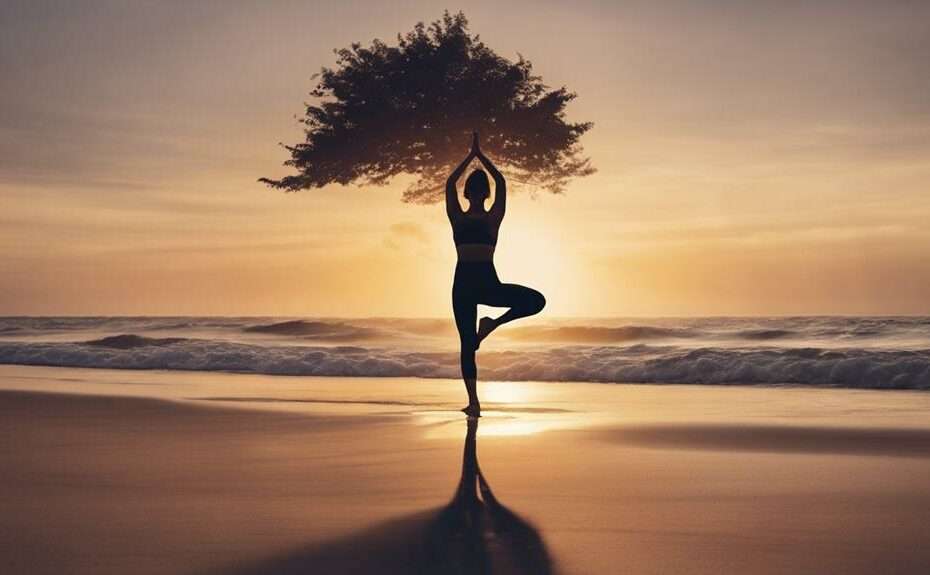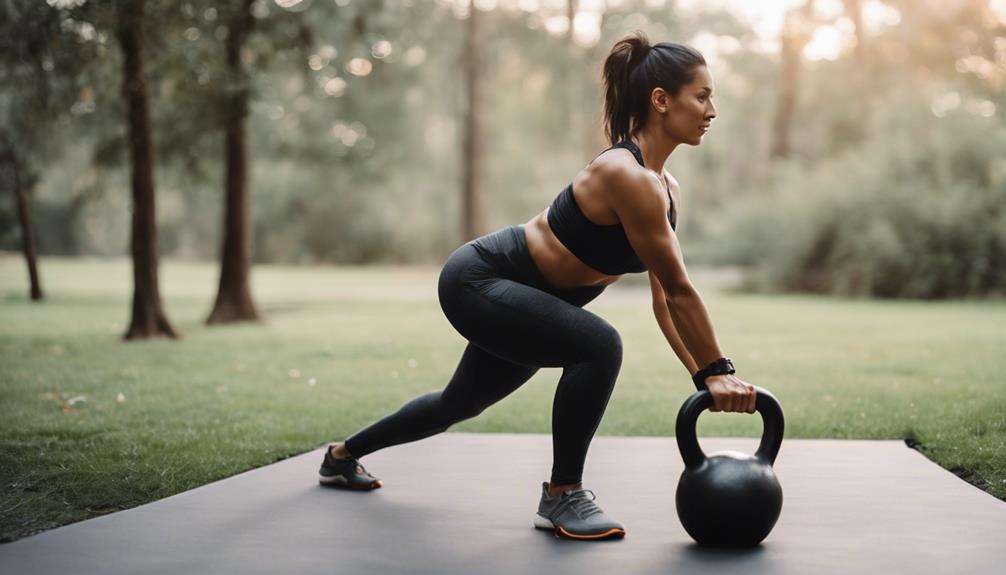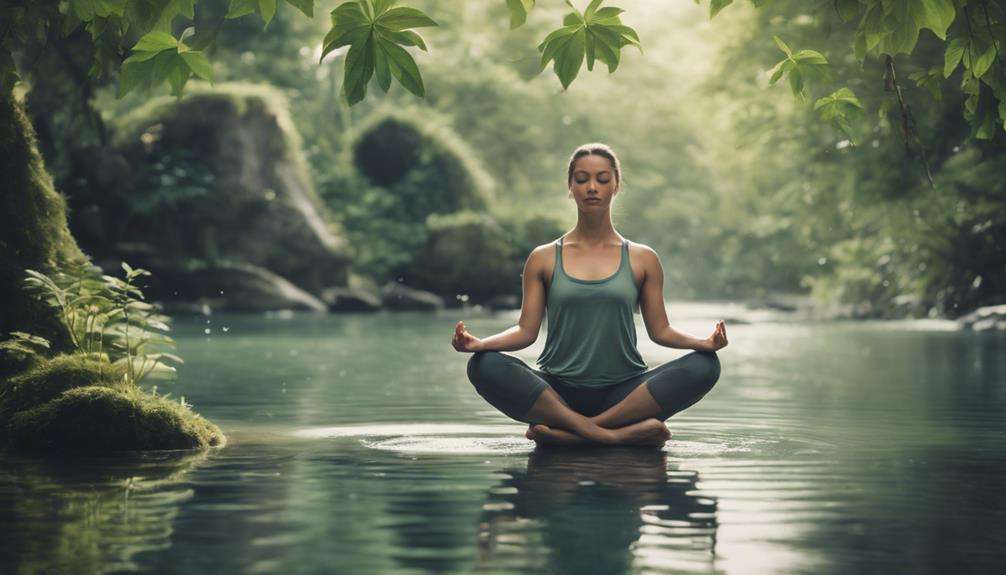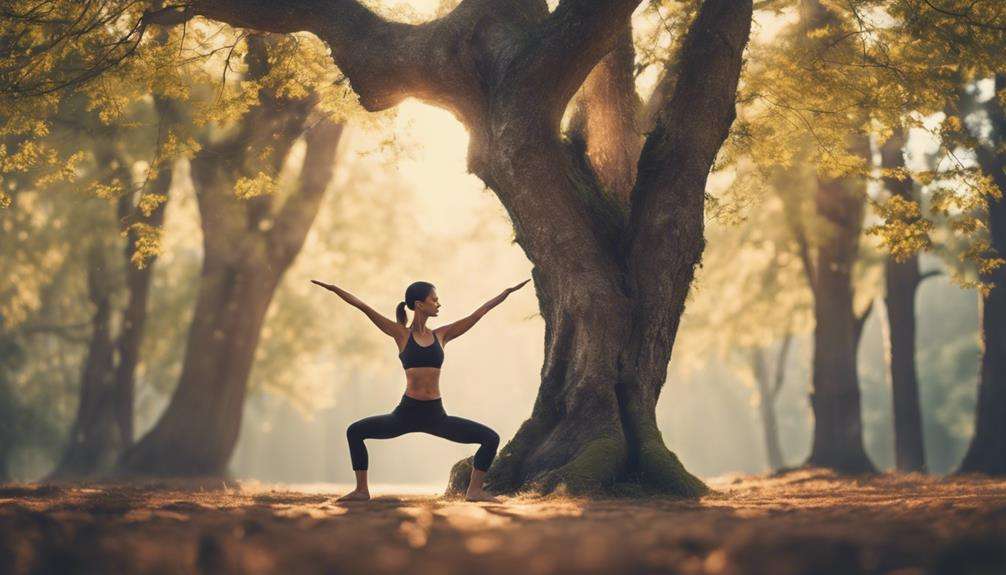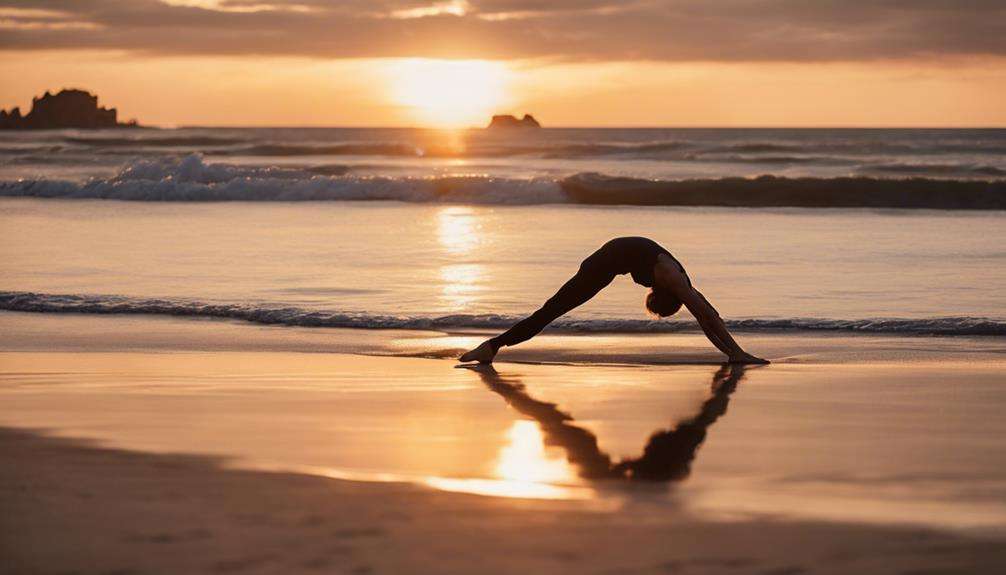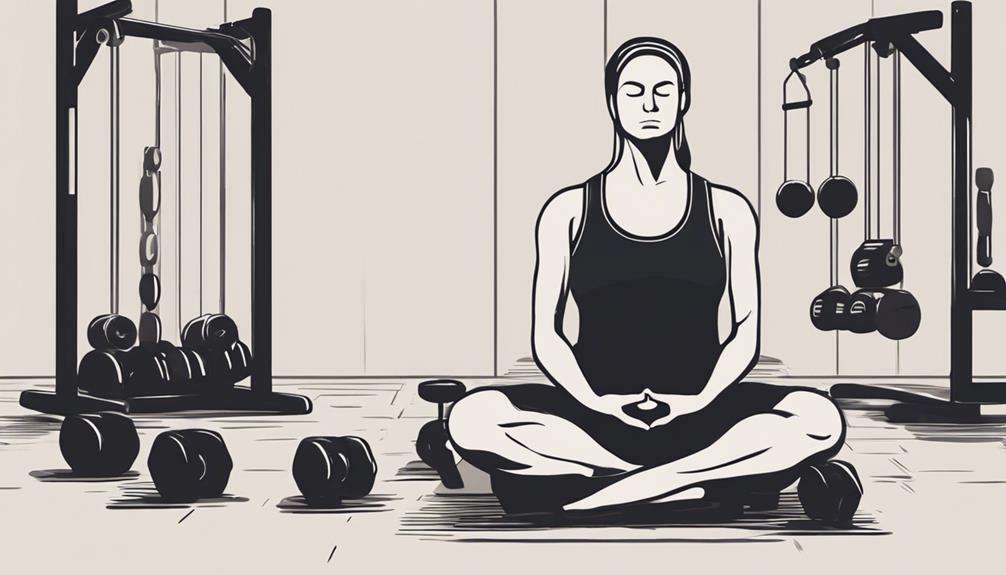Open the door to a stronger, more flexible you by exploring the transformative power of these yoga poses.
But remember, the key to opening your full potential lies not just in the poses themselves but also in the way you approach them.
Key Takeaways
- Enhance strength and flexibility through targeted poses for various muscle groups.
- Improve posture, balance, and range of motion with regular practice.
- Alleviate tension and enhance well-being by engaging in these diverse yoga poses.
- Tailor your practice with modifications and props for comfort and accessibility.
Intense Side Stretch Pose
Strengthen and stretch your hamstrings, calves, and hips deeply with the Intense Side Stretch Pose, also known as Parsvottanasana. This powerful yoga posture targets key areas like the hamstrings, calves, and hips, helping to enhance flexibility and strength.
By engaging your core muscles and focusing on your lower back, you can improve your overall posture through this pose. As you deepen into the stretch, feel the tension release in your lower body, allowing for increased range of motion in your hips and hamstrings over time.
To support your practice, consider using props like blocks or a chair to assist with alignment and accessibility. These props can provide the necessary support as you work on your form and gradually progress in the pose.
Remember to breathe deeply and listen to your body as you explore the Intense Side Stretch Pose, embracing the opportunity to cultivate both strength and flexibility in your practice.
Head to Knee Pose
As you explore the Head to Knee Pose, focus on the benefits it brings to your body, including stretching your hamstrings, calves, and spine. Guarantee proper alignment by keeping your back straight and leaning forward from your hips, gradually reaching towards your extended leg.
For beginners, consider using modifications like sitting on a folded blanket or using a strap to help you ease into the pose with comfort and support.
Benefits of the Pose
Incorporate Janu Sirsasana, the Head to Knee Pose, into your yoga routine to experience a myriad of benefits for your body and mind. This pose is fantastic for enhancing flexibility by stretching your spine, shoulders, and hamstrings.
Not only does it aid in detoxification and digestion by stimulating the liver and kidneys, but it also helps calm the mind, relieving mild depression and anxiety. Additionally, practicing Head to Knee Pose regularly can alleviate symptoms of menopause and menstrual discomfort.
Furthermore, this pose improves blood circulation, reducing fatigue and insomnia. Embrace the many advantages of Janu Sirsasana as you work towards a healthier and more balanced self.
Proper Alignment Tips
To secure proper alignment in the Head to Knee Pose (Janu Sirsasana), remember to engage your core muscles and keep your front leg active and foot flexed. This action helps activate the hamstring muscles effectively, supporting a straight spine.
For added support and alignment, consider using props like a yoga block under your sitting bones to elevate the hips. Engage your core to safeguard the lower back and guarantee a proper fold forward.
Focus on deep breathing to enhance the stretch while relaxing your shoulders. By maintaining a flexed foot, a straight spine, and proper alignment with the help of props and core engagement, you can experience the full benefits of the Head to Knee Pose while keeping your body safe and aligned.
Modifications for Beginners
For beginners practicing the Head to Knee Pose, consider using a folded blanket under your sitting bones to elevate the hips and facilitate a smoother forward bend. Keep the back knee bent or use a strap around the foot to assist in reaching the extended leg.
Focus on lengthening the spine by gradually reaching towards the toes to increase flexibility over time. Engage your core muscles and remember to breathe deeply to relax into the pose.
Start with a slight bend in the knee and work towards straightening it as your flexibility improves. By incorporating these modifications and techniques, you can effectively deepen the stretch in the Head to Knee Pose and progress in your yoga practice.
Cat-Cow Pose
Let's explore the benefits of Cat-Cow Pose.
Discover essential tips for proper form.
Learn about variations suitable for practitioners of all levels.
This sequence is excellent for enhancing spinal flexibility, promoting core strength, and fostering mind-body connection.
Remember to move with your breath, finding a gentle flow between arching and rounding your back to experience the full benefits of this rejuvenating pose.
Benefits of Cat-Cow
Discover the incredible benefits of practicing the Cat-Cow pose for your overall spinal health and flexibility. This gentle flow, consisting of Cat and Cow poses, is a fantastic way to improve spinal flexibility and mobility.
By smoothly shifting between rounding your back like a cat and arching it while lifting your chest like a cow, you can effectively stretch your back, torso, and neck. Not only does this movement help warm up your spine, but it also provides a soothing massage to your internal organs.
Regular practice of Cat-Cow can alleviate back pain, enhance your posture, and boost your overall spinal flexibility. Incorporate this gentle flow into your routine to experience these wonderful benefits.
Proper Form Tips
To confirm proper alignment in the Cat-Cow Pose, position your hands directly under your shoulders and your knees under your hips. Remember these tips for a successful practice:
- Engage your core muscles throughout the movement.
- Focus on gentle spinal flexion and extension.
- Coordinate your breath with each motion.
- Aim for a smooth and flowing change between the two poses.
Variations for All
Explore these accessible variations to enhance your Cat-Cow Pose practice and deepen your mind-body connection. If you experience back pain or tension, try widening your knees to increase stability and reduce strain on your lower back.
For those looking to stretch their chest and shoulders more, extend your arms forward on the mat during the Cow pose.
To target the neck and improve posture, gently rotate your head from side to side while in the Cat position.
Bow Pose
Experience the strengthening and flexibility benefits of Bow Pose (Dhanurasana) as you engage your back muscles and enhance your posture. This potent yoga pose offers a range of benefits for both the body and mind:
- Enhanced Spinal Flexibility: Bow Pose helps improve the flexibility of your spine, making it more supple and agile.
- Open Chest and Hip Flexors: By practicing Bow Pose, you can open up your chest and shoulders while also stretching your hip flexors.
- Improved Core Strength: Engaging your core and legs in Bow Pose helps in building overall body strength and endurance.
- Better Digestion and Blood Circulation: Regular practice of Bow Pose can aid in digestion, stimulate your organs, improve blood circulation, and boost energy levels.
Incorporating Bow Pose into your yoga routine can't only strengthen your back muscles and enhance your posture but also bring about a sense of equilibrium and energy to your body. Practice this pose mindfully and feel the transformative effects it has on your physical and mental well-being.
Low Lunge Pose
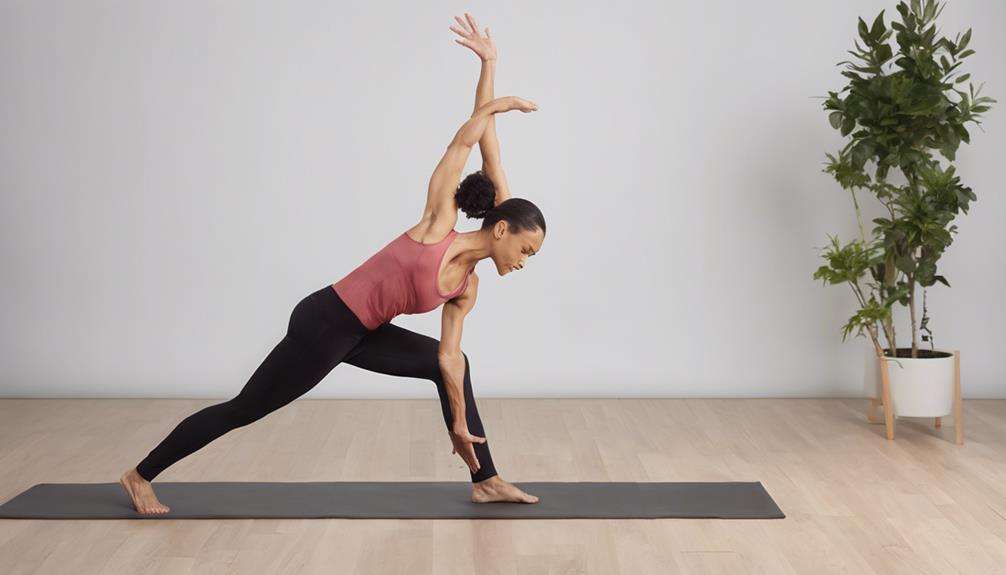
As you start exploring the Low Lunge Pose, you'll discover its numerous benefits for your body.
This pose not only enhances your hip and thigh flexibility but also strengthens your core muscles.
Remember to pay attention to proper alignment and explore various modifications to tailor the pose to your own needs.
Benefits of Low Lunge
Stretch and strengthen your hip flexors, quadriceps, and groin muscles with the beneficial Low Lunge pose, also known as Anjaneyasana. This pose offers various benefits for your body, such as:
- Improved Hip Flexibility: Low Lunge helps increase the flexibility and mobility of your hips.
- Relief from Lower Back Tension: By stretching the hip flexors and quadriceps, this pose can alleviate tension in the lower back.
- Enhanced Balance and Core Engagement: Practice Low Lunge to boost your balance, stability, and engage your core muscles effectively.
- Expanded Range of Motion: Regularly incorporating Low Lunge into your routine can lead to an overall increase in flexibility and range of motion.
Experience these benefits by integrating Low Lunge into your yoga practice regularly.
Proper Alignment Tips
Shifting from the benefits of Low Lunge, remember to keep your front knee aligned over the ankle to maintain proper alignment and prevent strain on the knee joint. Engage your core muscles to support your lower back and enhance stability during the pose.
Extend your back leg straight back with the knee lifted off the mat to increase flexibility and deepen the stretch. Press the top of your back foot firmly into the mat to activate the calf and hamstring muscles.
Relax your shoulders away from your ears and lengthen your spine to create space in your body. By focusing on these alignment tips, you can optimize the benefits of the Low Lunge pose while ensuring safety and effectiveness.
Variations for All
Enhance your Low Lunge pose by exploring various modifications tailored to all levels of practice. Low lunge stretches the hip flexors, quads, and hamstrings while improving balance, strength, and spinal mobility. Here are some variations to try:
- Add a gentle twist to promote spinal mobility.
- Raise your arms overhead to deepen the stretch in the hip flexors.
- Use blocks under your hands for better balance and support.
- Place a blanket under your back knee for added comfort during the pose.
Wide-Angle Seated Forward Bend

When practicing the Wide-Angle Seated Forward Bend, focus on engaging your core muscles and maintaining proper alignment to maximize its benefits. This pose offers a deep stretch for the inner thighs, hamstrings, and groins, promoting flexibility in these areas.
By regularly incorporating this pose into your routine, you can strengthen your spine, improve hip flexibility, and alleviate tension in the lower back. The Wide-Angle Seated Forward Bend is a powerful posture that not only enhances your overall flexibility but also contributes to better posture over time.
Remember to breathe deeply and relax into the stretch, allowing your body to gradually unfold. Embrace the sensation of release as you gently work towards greater strength and flexibility. With patience and consistent practice, you'll reveal the full potential of this pose and reap its many benefits for your body and mind.
Cow Face Pose
As you move from the Wide-Angle Seated Forward Bend to the Cow Face Pose, focus on the simultaneous stretching of your hips, shoulders, and chest for enhanced flexibility and mobility. Gomukhasana, also known as Cow Face Pose, is a beneficial yoga posture that targets multiple areas of the body to increase flexibility and promote overall well-being.
- Cow Face Pose helps open up the shoulders, relieving tension and stiffness in this area.
- The stretch across the chest in Gomukhasana can improve posture and spinal alignment.
- By targeting the hips, Cow Face Pose aids in enhancing flexibility in this often tight area.
- Props like yoga blocks or straps can be used to modify the pose, allowing for greater accessibility and deeper stretching.
Incorporating Cow Face Pose into your yoga routine regularly can lead to increased flexibility, improved posture, and a greater sense of ease in your body. Embrace the stretch and feel the benefits of this pose unfold with each practice session.
Plow Pose
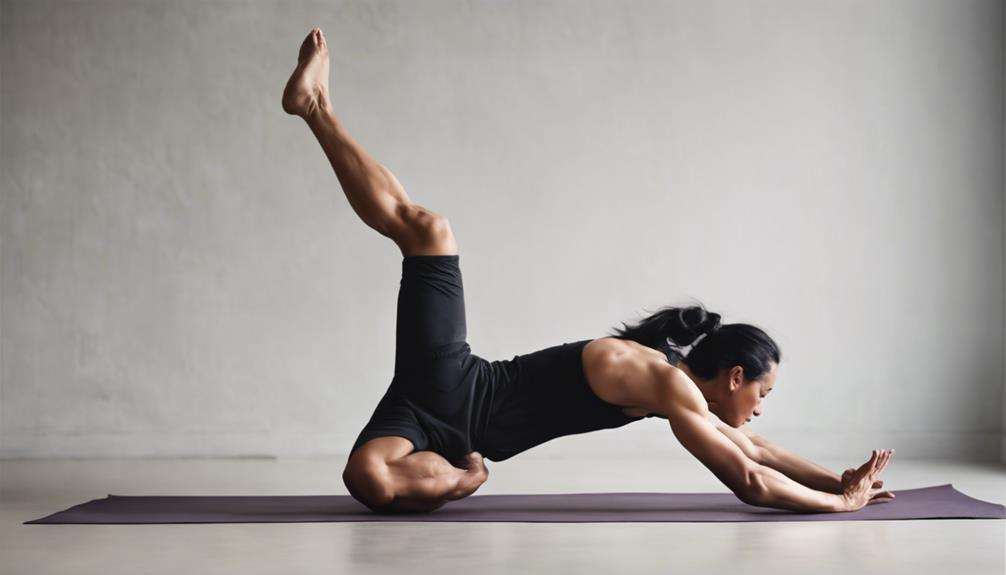
To practice the Plow Pose effectively, begin by lying on your back and gently lifting your legs over your head to touch the floor behind you. This pose offers a deep stretch for your spine, shoulders, and hamstrings, promoting flexibility and relieving tension.
As you hold the Plow Pose, focus on engaging your core muscles to support your back and maintain proper alignment, preventing strain on your neck and spine. Additionally, the inversion created by this pose stimulates the thyroid gland, which can help regulate metabolism and enhance overall well-being.
Eye of the Needle Pose
Explore the benefits of Eye of the Needle Pose to enhance your hip flexibility and release tension in the lower back and hips. This pose, also known as Sucirandhrasana, is a wonderful way to target the outer hips and glutes, aiding in hip flexibility and mobility. By incorporating this pose into your routine, you can experience a sense of comfort and improved flexibility in your hip movements. Here are some key points to ponder:
- Stretching the outer hips and glutes helps improve hip flexibility.
- Release tension in the lower back and hips for enhanced comfort.
- Enhances hip mobility, benefiting activities like running and sitting cross-legged.
- Increases range of motion, reducing tightness in the hips.
Regular practice of Eye of the Needle Pose can lead to significant improvements in your hip flexibility, overall comfort, and range of motion. Enjoy the benefits of this gentle yet effective pose in your yoga practice.
Downward-Facing Dog Pose
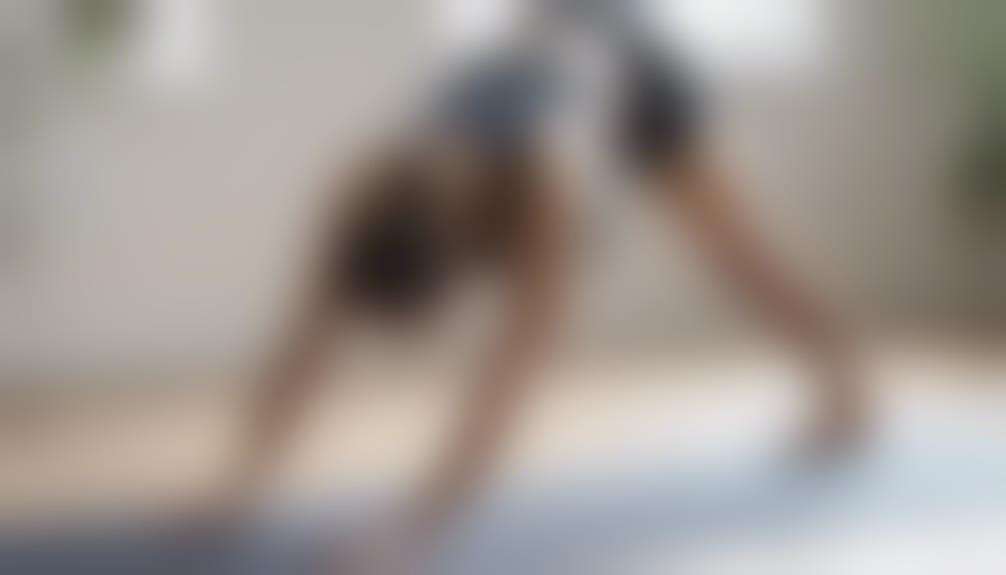
Begin by positioning yourself on your hands and feet, lifting your hips up and back to form an inverted V shape with your body in Downward-Facing Dog Pose. This foundational yoga pose is excellent for strengthening your arms, shoulders, and core.
As you hold the pose, focus on elongating your spine, feeling the stretch in your hamstrings and calves. Downward-Facing Dog also works wonders for improving circulation throughout your body.
The benefits extend beyond strength and flexibility; this pose can aid digestion, relieve mild back pain, and enhance your overall well-being. Incorporating Downward-Facing Dog Pose into your regular practice can lead to improved posture, increased body awareness, and a sense of calm.
Embrace this pose not just for its physical benefits but also for the mental clarity and balance it brings to your yoga practice.
Frequently Asked Questions
What Type of Yoga Is Good for Strength and Flexibility?
For strength and flexibility, Power Yoga, Vinyasa Flow, and Ashtanga Practice are excellent choices. These styles emphasize muscle engagement, core strength, and dynamic movements. Incorporate balance poses for a well-rounded practice that enhances both strength and flexibility.
What Yoga Pose Requires the Most Flexibility?
To increase flexibility, tackle advanced poses like Wheel Pose for extreme flexibility challenges. Stretch with care, pushing your limits for flexibility progress. Listen to your body, embrace flexibility training, and celebrate flexibility milestones and achievements.
How Do You Promote Greater Flexibility?
To promote greater flexibility, focus on stretching techniques, mobility drills, and joint flexibility. Engage in flexibility exercises, gradually increasing difficulty. Overcome flexibility challenges by setting flexibility goals and tracking progress. Consistent flexibility training will lead to flexibility benefits.
How Can I Become More Flexible in Yoga?
To become more flexible in yoga, set flexibility goals, benefit from yoga's stretching techniques, track progress, practice various poses, engage in flexibility training, incorporate breathing exercises, relax muscles, and witness flexibility improvements over time.
Conclusion
Incorporating these yoga poses into your routine can lead to greater strength and flexibility. Did you know that regular practice of yoga has been shown to improve overall physical health and reduce the risk of injuries by 20%?
Keep up the good work and continue to reap the benefits of increased range of motion, reduced muscle tension, improved posture, and enhanced well-being. Remember, consistency is key in achieving your fitness goals.
Keep stretching and strengthening your body with these poses!
